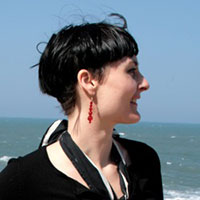
Jess MACNEIL
Jess MacNeil works between painting, installation, video and photography.
Her work was included in ‘Primavera’ at the Museum of Contemporary Art, Sydney, in 2008 and presented at the Tokyo Metropolitan Museum of Photography and the Museum of Contemporary Art San Diego in 2009. She was awarded the Anne & Gordon Samstag Scholarship in 2006 and studied at the Slade School, London 2007/8.
For more information: http://jessmacneil.com
AQUEOUS TRACE
[Dream Worlds 30 second preview]
AQUEOUS TRACE (DETAIL), 2009, high definition video with sound, courtesy of the artist and GALLERY BARRY KELDOULIS
Aqueous Trace presents a moving image of lanes in a swimming pool, looped endlessly and seamlessly. The footage has been digitally manipulated to remove the bodies of the swimmers in the pool, leaving the conditions and effects of their presence.
The absent bodies of the swimmers are emphatically implicated by the surrounding context. Splashes, ripples and shadows allow us to follow their passage. The possibility of a glimpse or slip of an individual’s arm or leg is continually insinuated, but always just out of reach.
Larger waves spilling across the image from outside the frame disintegrate the image, skew the lanes and thwart the paths of the swimmers, who tumble against their force and their froth. Randomness is introduced to the scene, and a sense of proportion and situation. Aqueous Trace portrays a sequence within a greater world, tracing the effects of human passage in an environment we cannot possibly control, yet are irrevocably implicated within.
That the swimmers are gone but their effect remains highlights the repercussions of our presence and actions, left to play out in our wake. On one hand this alludes to chaos theory and the bewildering possibilities implied by what is commonly known as “the butterfly effect”. On the other it inevitably suggests contemplation of loss, and questioning of what this implies for that which is left behind but cannot be disentangled from what has been lost.
The video loops infinitely; a once unique moment now endlessly repeated. The small waves of influence caused by the body of a swimmer continue to resonate. Like memory, like the tides, they return. The work examines the transience of individual passage extended and repeated to potential infinity.
Aqueous Trace is a meditation on time, cause and effect, and human habitation of our environment, and continues my ongoing artistic negotiation of these concerns.
Authored: Jess MacNeil
Technical Assistance: Dan Kripac
Jess MACNEIL - AQUEOUS TRACE
Jess MacNeil 工作领域涉及绘画、装置、视频和摄影。
他的作品在2008年被悉尼当代美术馆收藏,并于2009年在东京都写真美术馆和圣地亚哥当代美术馆展出。她在2006年被授予Anne & Gordon Samstag 奖学金并于2007年在伦敦斯莱德学校学习。
更多信息: http://jessmacneil.com
作品名:
AQUEOUS TRACE, 2009, 视频环
AQUEOUS TRACE (DETAIL), 2009, 视频环
澳洲邦迪海滩,一月是一个日常生活场景的抽象体现——人们在涨潮的海水游泳池中遭到层叠浪潮的“进攻”。水的有机运动以及泳池的基本几何形状让这一场景变得抽象;动荡的图片飞机,类似于一幅不断摆动、倒塌、瓦解的色域绘画。
作品中结构和概念上的冲突既介于混乱与秩序、分离与崩溃之间,又深藏于二者中。邦迪冰山的海水游泳池为那些相较而言的庇护所和橙色线标记提供了一种概念上的水中身体的分离。这个作品记录了水空间中人体的运动,强调了这种运动随着时间的变化呈现出的的柔顺性。
作者: Jess MacNeil
技术支持: Dan Kripac